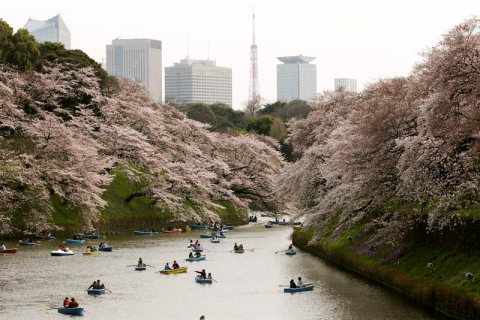April 1, 2016 – TOKYO – Thousands of people, including tourists, are gathering to enjoy Japan’s cherry blossom season, when cherry trees, or “sakura” as they are known locally, begin to flower, laying out a pink carpet in parks, avenues and temple lawns; their distinctive color overflowing to tinge everything from shop windows to beer cans.
Although Japan’s Meteorological Agency had announced on March 21 that cherry trees were beginning to flower in Tokyo’s Yasukuni temple, the Japan National Tourism Organization, or JNTO, said on Thursday, March 31 is the day when the flowers are expected to be at their best.
Cherry trees in parks such as Ueno, home to 1,200 such specimens, or the centrally located Hibiya, enticed visitors Thursday to walk among or picnic beneath trees bursting with the happy color.
“Cherry trees are beautiful, a symbol of Japan. Their flowering is the spring itself, and one realizes the cold of the winter has given way to the new season,” Ayako Sakai, a 34-year-old who works in the chemical industry and who eats and takes a walk under the sakura twice a week while the phenomenon lasts, told EFE.
Sakai added she has been visiting the park since she was a child to practice “hanami,” or to meet under cherry blossoms to gaze at their beauty, which has become “something cultural.”
 However, the Japanese are not the only ones drawn by the spring landscape, as an increasingly higher number of tourists visit the Asian country from end of March until the beginning of April, the peak season for cherry blossoms.
However, the Japanese are not the only ones drawn by the spring landscape, as an increasingly higher number of tourists visit the Asian country from end of March until the beginning of April, the peak season for cherry blossoms.
In 2015, over 1.5 million foreigners arrived in the country in March and over 1.7 million in April, a year-on-year jump of 45.3 and 43.3 percent respectively, according to JNTO figures.
Hanami, which traditionally marked the New Year’s harvest, and the beginning of the rice-sowing season, was originally a practice limited to the Japanese nobility but gained popularity during the Edo period (1603-1867).
The Japanese fascination for cherry trees has spanned several internet applications too, which help one keep a close eye on the sakura season, from the moment and place the first petals sprout, to the effect of atmospheric pressure on the delicate flowers, which barely last a couple of weeks.
Businesses and commercial establishments too design and sell exclusive products targeted at this time of the year.
Hotels offer special packages, restaurants serve menus in cherry blossom-hues and shopping malls such as Midtown sell traditional food and sweet boxes for picnics.
Shop windows too are momentarily swamped with rose wines, sakura beers, rose-pink rice balls and coffees or cherry blossom-shaped sweets.

